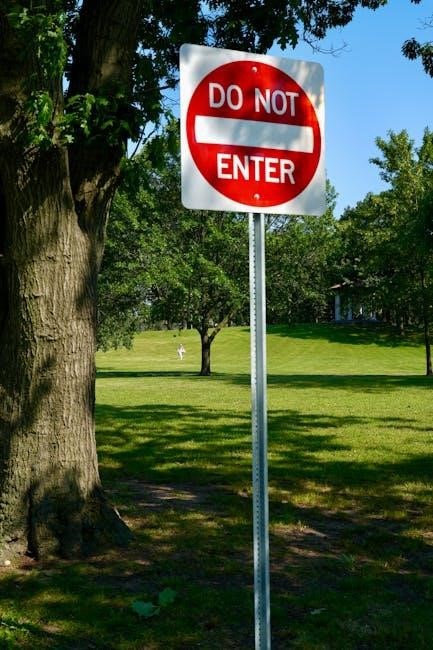Welcome to this guide on resetting the ECU for your 2006 Dodge Charger SRT8․ This comprehensive guide will walk you through the process step-by-step‚ helping you troubleshoot issues‚ improve performance‚ and maintain your vehicle’s optimal condition․ Whether you’re addressing error codes or seeking to restore factory settings‚ this guide provides the essential information you need to successfully reset your ECU and get back on the road with confidence․
What is an ECU and Its Role in the 2006 Dodge Charger SRT8
The Engine Control Unit (ECU)‚ also known as the Powertrain Control Module (PCM)‚ is the brain of your 2006 Dodge Charger SRT8․ It regulates engine performance by processing data from various sensors‚ such as oxygen levels‚ air intake‚ and throttle position․ The ECU ensures optimal fuel injection‚ ignition timing‚ and emissions control‚ adapting to driving conditions for peak efficiency and power․ It also monitors and manages systems like traction control and stability‚ enhancing safety and responsiveness․ If the ECU detects issues‚ it triggers warning lights or error codes‚ guiding diagnostics․ Resetting the ECU can clear stored error codes‚ recalibrate settings‚ and restore factory performance‚ making it a valuable procedure for maintaining your vehicle’s health and reliability․
Why Reset the ECU in Your 2006 Dodge Charger SRT8?
Resetting the ECU in your 2006 Dodge Charger SRT8 can resolve various issues and improve performance․ If error codes appear‚ such as the “Check Engine” light‚ an ECU reset can clear them‚ potentially eliminating the need for costly repairs․ Additionally‚ after modifications or repairs‚ resetting the ECU allows it to recalibrate and adapt to new components or changes․ This ensures the engine operates efficiently and maintains optimal power and fuel efficiency․ Furthermore‚ an ECU reset is useful for addressing issues like intermittent throttle problems or preparing for state inspections when emission monitors show “not ready․” While it won’t fix mechanical faults‚ it’s a valuable diagnostic and maintenance step to restore your vehicle’s performance and ensure smooth operation․

Preparation Steps Before Resetting the ECU
Gather necessary tools like a scan tool or fuses․ Ensure the vehicle is in a safe‚ stationary position on level ground with the transmission in park․ Consult your manual for specific instructions to avoid errors during the reset process․
Understanding the Tools and Materials Needed
To reset the ECU on your 2006 Dodge Charger SRT8‚ you’ll need specific tools depending on the method you choose․ For the ignition cycle technique‚ ensure you have the ignition key and a firm grasp of the gas pedal․ If using the fuse removal method‚ locate the passenger-side fuse box and identify fuses 11‚ 14‚ and 16․ A wrench or fuse puller may be necessary for removal․ For the battery disconnect technique‚ you’ll need to access the negative battery terminal and a wrench to disconnect it safely․ A scan tool is required for advanced resets‚ allowing you to clear codes and monitor the ECU․ Always refer to your owner’s manual or a trusted guide to ensure you have the correct tools and materials for the job‚ avoiding potential damage to your vehicle’s electrical system․
Ensuring the Vehicle is in a Safe Environment
Before resetting the ECU on your 2006 Dodge Charger SRT8‚ ensure the vehicle is in a safe environment․ Park on a level surface‚ away from traffic‚ and engage the parking brake․ Turn off the engine and all accessories to prevent accidental starts or electrical interference․ Place the transmission in “Park” (automatic) or first gear (manual)․ Avoid working near open flames or sparks‚ as fuel vapors can ignite․ Do not press the brake pedal or accelerator during the reset process․ Ensure the ignition is in the “OFF” position before starting any method․ If using the battery disconnect technique‚ disconnect the negative terminal last to avoid short circuits․ Always refer to your owner’s manual for specific precautions and consult a professional if unsure․ Safety is paramount to avoid damage to your vehicle or personal injury․

Step-by-Step Instructions for ECU Reset
Follow detailed methods like ignition cycling‚ fuse removal‚ or battery disconnection to reset your 2006 Dodge Charger SRT8’s ECU․ Each technique ensures a safe and effective reset process․
Method 1: Ignition Cycle Technique
Insert the ignition key and turn it to the “ON” position without starting the engine․ Press the gas pedal to the floor and hold for five seconds․ Release the pedal‚ then turn the key to “OFF․” Wait at least two minutes to allow the ECU to reset․ This method is effective for clearing stored error codes and adaptive memory‚ potentially improving issues like rough idling or performance․ After resetting‚ drive the car to allow the ECU to relearn normal operating parameters․ Ensure the vehicle is in a safe environment with minimal electrical load before attempting this technique․
Method 2: Fuse Removal and Replacement
Open the hood and locate the fuse box on the passenger side․ Remove fuses 11‚ 14‚ and 16‚ as indicated on the fuse box cover․ Set them aside․ Insert the ignition key and turn it to the “ON” position without starting the engine․ Allow the vehicle to remain in this state for 30 seconds․ Re-insert the fuses in the correct order: first 11‚ then 14‚ and finally 16․ Turn the ignition key to the “OFF” position․ Start the engine and let it run for a few minutes to allow the ECU to reset and relearn its parameters․ This method can help clear error codes and restore proper engine function․ Ensure all electrical systems are stable before driving the vehicle․
Method 3: Battery Disconnect Technique
Disconnect the negative battery cable to drain the vehicle’s electrical system completely․ Wait at least 30 minutes to ensure the ECU has fully discharged․ Reconnect the negative cable securely․ Start the engine and allow it to run for several minutes․ This method forces the ECU to reset all stored data‚ clearing fault codes and recalibrating sensors․ Drive the vehicle normally to allow the ECU to relearn operating parameters․ Note: This method may cause temporary loss of settings like radio presets or clock․ Ensure all electrical systems function properly before driving․ This is a straightforward approach to reset the ECU without specialized tools‚ ideal for addressing issues like pending error codes or intermittent problems․ Always follow proper safety precautions when working with batteries to avoid injury or damage․
Method 4: Using a Scan Tool for ECU Reset
Using a scan tool is the most precise method to reset the ECU in your 2006 Dodge Charger SRT8․ Connect the scan tool to the vehicle’s OBD-II port‚ typically located under the steering column․ Turn the ignition to the “ON” position and power on the scan tool․ Navigate to the “Control Module” or “ECU Reset” section in the tool’s menu․ Select the “Reset” or “Clear Codes” option to initiate the process․ The tool will communicate with the ECU to erase stored fault codes and reset adaptive learning parameters․ Once complete‚ turn the ignition off‚ wait a few minutes‚ and restart the engine to test․ This method is recommended for addressing specific issues like error codes or performance adjustments․ Ensure the scan tool is compatible with your vehicle’s make and model for accurate results․ Always refer to the tool’s instructions for detailed steps․ This method is ideal for diagnosing and resolving complex ECU-related problems efficiently․

Post-ECU Reset Procedures
After resetting the ECU‚ allow your 2006 Dodge Charger SRT8 to relearn its operating parameters by driving normally․ Monitor dashboard lights and performance improvements․ Ensure all systems function properly and clear any remaining codes using a scan tool if necessary․ Test drive the vehicle to confirm the reset was successful and address any lingering issues promptly․ This step ensures your car returns to optimal performance and maintains reliability․
Allowing the ECU to Relearn Normal Operating Parameters

After resetting the ECU‚ your 2006 Dodge Charger SRT8 will need time to relearn its normal operating parameters․ This process‚ often referred to as “retraining‚” allows the engine control unit to adapt to your driving habits and vehicle conditions․ Start by driving the vehicle under various conditions‚ such as city driving‚ highway speeds‚ and varying acceleration rates․ Avoid extreme driving behaviors during this period․ The ECU will monitor and adjust fuel injection‚ ignition timing‚ and other critical systems based on the data collected․ This relearning phase typically takes a few miles of driving but may vary depending on the vehicle’s history and the nature of the reset․ Patience is key to ensuring the ECU accurately recalibrates for optimal performance and efficiency․
Testing the Vehicle After Reset
After resetting the ECU‚ it’s crucial to test the vehicle thoroughly to ensure proper functionality․ Start with a short drive‚ observing the dashboard for any warning lights‚ especially the “Check Engine” light․ If it remains off‚ this is a good sign․ Gradually increase speed and vary driving conditions to allow the ECU to recalibrate․ Pay attention to engine performance‚ acceleration smoothness‚ and overall responsiveness․ If the ECU reset was successful‚ the vehicle should run smoothly without stalling or hesitation․ Complete a series of starts‚ stops‚ and acceleration cycles to confirm stability․ If issues persist‚ such as rough idling or decreased performance‚ further troubleshooting or professional assistance may be necessary․ Testing ensures the reset was effective and the vehicle operates as intended․

Troubleshooting Common Issues After ECU Reset
Common issues after ECU reset include the “Check Engine” light remaining on‚ error codes persisting‚ or intermittent problems like throttle body issues requiring a restart․
Addressing the “Check Engine” Light
If the “Check Engine” light remains on after resetting the ECU‚ it may indicate unresolved issues or incomplete relearning of parameters․ Start by using a scan tool to retrieve and clear any error codes․ If the light persists‚ ensure all components like the catalytic converter and oxygen sensors are functioning properly․ Drive the vehicle under various conditions to allow the ECU to relearn operating parameters․ For intermittent issues‚ try the ignition cycle technique or disconnecting the battery․ If the problem recurs‚ inspect throttle body connections and clean or replace if necessary․ If unresolved‚ consult a professional mechanic to diagnose deeper system faults․ Always address underlying causes to prevent the light from returning․
Resolving ECU-Related Error Codes
After resetting the ECU‚ it’s crucial to address any lingering error codes using a scan tool․ Retrieve the codes to understand the issue‚ such as oxygen sensor or catalytic converter problems․ Clear the codes through the scan tool and test drive the vehicle to ensure they don’t reappear․ If issues persist‚ inspect related components for damage or malfunction․ For example‚ check the throttle body for proper function or clean it if necessary․ Sometimes‚ intermittent errors can be resolved by repeating the ECU reset process․ If codes remain‚ consult the owner’s manual or a professional for advanced troubleshooting․ Remember‚ resolving error codes promptly prevents further complications and maintains your vehicle’s performance and efficiency on the road․

Understanding ECU Reset Methods
ECU reset methods for your 2006 Dodge Charger SRT8 include ignition cycling‚ fuse removal‚ battery disconnection‚ and using a scan tool․ Each method targets specific needs‚ ensuring optimal performance and troubleshooting efficiency‚ tailored to your vehicle’s requirements․
Differences Between Hard and Soft Resets
A hard reset involves completely draining the ECU’s power‚ typically by disconnecting the battery or removing specific fuses‚ resulting in a full system reset․ This method is more thorough and often used to resolve persistent issues or after significant modifications․ A soft reset‚ on the other hand‚ is less invasive and usually involves ignition cycling or pressing the gas pedal in a specific sequence․ Soft resets are ideal for minor adjustments or clearing error codes without losing stored data․ Both methods are safe when performed correctly‚ but a hard reset may require relearning normal operating parameters‚ while a soft reset retains most settings․ Choosing the right method depends on the severity of the issue and the desired outcome for your 2006 Dodge Charger SRT8․
When to Choose a Full ECU Reset
A full ECU reset is recommended when addressing persistent issues that a soft reset cannot resolve‚ such as severe error codes‚ faulty sensor calibrations‚ or after significant repairs or upgrades․ This method is also ideal when the ECU has developed corrupted data that affects vehicle performance․ A full reset‚ often achieved by disconnecting the battery or removing specific fuses‚ completely drains the ECU’s memory‚ allowing it to restart with a clean slate․ This process is beneficial for resolving issues like intermittent throttle problems or “Check Engine” lights that remain illuminated․ However‚ it requires the ECU to relearn normal operating parameters‚ which may take some time and driving․ A full reset ensures a thorough restoration of the ECU’s functionality‚ making it a reliable solution for complex problems in your 2006 Dodge Charger SRT8․

Maintenance Tips After ECU Reset
After resetting the ECU‚ drive your vehicle to allow the system to relearn normal operating parameters․ Regular inspections and software updates ensure optimal performance and prevent issues․
Regular Vehicle Inspection
After resetting the ECU‚ regular inspections are crucial to ensure your 2006 Dodge Charger SRT8 runs smoothly․ Start by checking the battery connections for cleanliness and tightness‚ as a weak connection can cause ECU issues․ Inspect the fuse box‚ particularly fuses 11‚ 14‚ and 16‚ to ensure they are securely in place․ Examine the gas pedal and throttle body for proper function and cleanliness‚ as these components directly affect the ECU’s performance․ Additionally‚ monitor the dashboard lights and error codes to catch potential problems early․ Regular oil changes‚ air filter replacements‚ and tire pressure checks are also essential․ By maintaining these habits‚ you can prevent future ECU-related issues and keep your vehicle in top condition․ A well-maintained car is less likely to require repeated resets or repairs․
Updating ECU Software
Updating the ECU software on your 2006 Dodge Charger SRT8 is crucial for maintaining optimal performance and addressing any issues․ The ECU‚ acting as the car’s brain‚ controls essential functions like engine timing and fuel injection․ Outdated software may lead to decreased performance or error lights․ To update‚ use a scan tool connected to the OBD-II port‚ typically located under the steering wheel․ Ensure you obtain the latest software from a reliable source‚ such as Dodge’s official website or a dealership․ Follow step-by-step guides or tutorials to avoid interruptions‚ which could potentially damage the ECU․ Consider consulting forums or enthusiast groups for model-specific advice․ While DIY is possible‚ if unsure‚ seek professional help to prevent issues․ Post-update‚ allow the ECU to adapt by driving the car to let it relearn settings․ Carefully weigh the costs and risks of DIY versus professional service․

FAQs About 2006 Dodge Charger SRT8 ECU Reset
Q: Does ECU reset void the warranty? Resetting the ECU typically doesn’t void the warranty unless unauthorized modifications are made to the software․ Always consult your warranty terms․
Q: Can I perform an ECU reset myself? Yes‚ you can reset the ECU using methods like battery disconnect‚ fuse removal‚ or scan tools․ However‚ professional assistance is recommended for complex issues․
Does ECU Reset Void the Vehicle Warranty?
Resetting the ECU on your 2006 Dodge Charger SRT8 typically does not void the vehicle warranty․ However‚ it is crucial to ensure that the reset is performed correctly and only to address legitimate issues․ Unauthorized modifications to the ECU software or tampering with the system can void the warranty․ Always refer to your warranty terms and conditions to understand what is covered and what may void it․ If in doubt‚ consult a certified dealership or a trusted mechanic to avoid any potential warranty issues․ Remember‚ resetting the ECU should only be done for diagnostic or maintenance purposes‚ not for making unauthorized changes to the vehicle’s programming․

Can I Perform ECU Reset Myself?
Yes‚ you can perform an ECU reset on your 2006 Dodge Charger SRT8 yourself with the right guidance․ Basic methods include disconnecting the battery‚ removing specific fuses‚ or using the ignition cycle technique․ These procedures are straightforward and require minimal tools․ However‚ for more complex resets or if you encounter error codes‚ using a scan tool is recommended․ Ensure you follow step-by-step instructions carefully to avoid any issues․ If you’re unsure or uncomfortable with the process‚ consulting a professional mechanic is advisable․ Proper execution of an ECU reset can help resolve minor issues without the need for costly repairs‚ making it a useful skill for car owners․ Always prioritize safety and caution when working with electrical systems to prevent any potential damage to your vehicle․
Resetting the ECU on your 2006 Dodge Charger SRT8 can resolve various issues and restore performance․ Always follow proper procedures to ensure safety and effectiveness․
Final Thoughts on ECU Reset for 2006 Dodge Charger SRT8
Resetting the ECU on your 2006 Dodge Charger SRT8 can be a straightforward process when done correctly․ Whether you’re addressing error codes‚ improving performance‚ or preparing for inspections‚ this procedure offers a cost-effective solution․ Always ensure safety by following proper steps and using the right tools․ If unsure‚ consult a professional or the owner’s manual․ Remember‚ a successful reset allows the ECU to relearn your vehicle’s parameters‚ ensuring optimal performance․ Regular maintenance and inspections can prevent future issues․ With careful attention‚ your Charger will continue to deliver the power and reliability you expect․ Resetting the ECU is a valuable skill for any Dodge Charger SRT8 owner looking to maintain their vehicle’s peak condition․